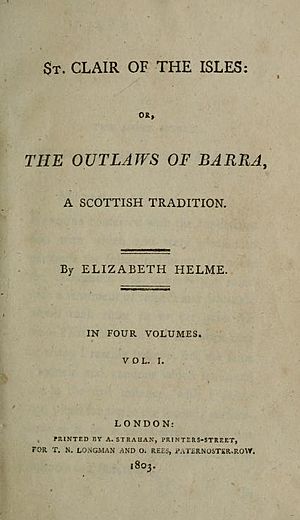Elizabeth Helme facts for kids
Elizabeth Helme (born August 8, 1743 – died January 1, 1814) was a talented English writer. She wrote many novels, educational books, and translated other works. She was active in the late 1700s and early 1800s.
Contents
About Elizabeth Helme
Elizabeth Helme was probably born in County Durham, England. Her family's name might have been Horrobin. Later, her family moved to London. There, she met William Helme (who lived from about 1747 to 1822). They got married in 1772 and had five children together.
One of their daughters, Elizabeth Somerville (1774–1840), also became a writer. Elizabeth Helme worked as a teacher too. She translated children's plays by a writer named Joachim Heinrich Campe. These plays included Cortez (1799) and Pizarro (1800). Many of her own books were also written for young readers.
Even though Elizabeth and her husband worked as teachers and she wrote many books, her family sometimes struggled with money.
Her Books and Stories
Elizabeth Helme published her first novel, Louisa; or, The Cottage on the Moor, in 1787. At first, she didn't put her name on it. This book became one of her most popular works. Her first book published with her name on it was The Farmer of Inglewood Forest in 1796. This book was published by a well-known company called Minerva Press.
Later, in 1838, a play called St. Clair was created by Elizabeth Polack. This play was based on Elizabeth Helme's novel, St Clair of the Isles.
Elizabeth Helme is also mentioned in a book called Mothers of the Novel: 100 Good Women Writers Before Jane Austen by Dale Spender. This book talks about important women writers who were sometimes forgotten.
Elizabeth Helme's Works
Elizabeth Helme wrote many different kinds of books.
Novels (Fiction Stories)
- Louisa; or the Cottage on the Moor (1787)
- Clara and Emmeline: or, the Maternal Benediction (1788)
- Duncan and Peggy; a Scottish Tale (1794)
- The Farmer of Inglewood Forest (1796)
- Albert, or The Wilds of Strathnavern (1799)
- St Margaret's Cave: or, The Nun's Story. An Ancient Legend (1801)
- St Clair of the Isles (1803)
- The Pilgrim of the Cross, or Chronicles of Christabelle de Mowbray (1805)
- Magdalen, or The Penitent of Godstow (1812)
- Modern Times; or, The Age We Live In (1814) (This book was published after she passed away)
Non-fiction (Fact-based Books)
- Instructive rambles in London, and the adjacent villages. Designed to amuse the mind, and improve the understanding of youth. (1798)
- Instructive Rambles Extended (1800)
- The History of Scotland: Related in Familiar Conversations, by a Father to His Children (1806)
- The History of England, Related in Familiar Conversations, by a Father to His Children (1806)
- Maternal Instruction or Family Conversations on Moral and Entertaining Subjects (1807)
- The History of Rome from the Foundation of the City to the Fall of the Eastern Empire (1808)
- The Fruits of Reflection; or, Moral Remembrances on Various Subjects. Designed for the perusal of youth (1809)
Translations (Books She Translated)
- Travels from the Cape of Good-Hope, into the Interior Parts of Africa (from French by Francois Le Vaillant) (1790)
- St. Alma, a novel (from French by Jean Claude Gorjy) (1791)
- Cortez: or, The Conquest of Mexico, as related by a father to his children (from German by Joachim Heinrich Campe) (1799)
- Pizarro; or, the conquest of Peru, as related by a father to his children (from German by Joachim Heinrich Campe) (1799)
- Columbus; or, The discovery of America, as related by a father to his children (from German by Joachim Heinrich Campe) (1811)


